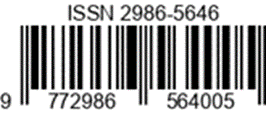Pangaranto Sailaon as an Expression in Karaya Music
Keywords:
Tradition, Ethnicity, Form, Structure, PresentationAbstract
Although Batak socio-cultural changes in overseas can be distinguished, they are difficult to separate. Change, social refers more to changes in structure, while cultural change is more oriented towards changes in the thinking system of the community. Given that human life is shrouded in culture, culture itself is created and developed in social life. Therefore, cultural change is not something that needs to be mourned or prevented. Cultural change must be observed in terms of meeting the needs of the Batak community itself, so cultural change will always take place, along with social changes themselves. From the idea of composite cultivation the author does not talk about the course of events about Batak culture assimilating with other cultures, because each ethnicity has its own identity and characteristics, but provides one of the offers in sound language to express the expression of "emotions" of Batak people in a new environment, where Batak people meet the needs of life about a form of togetherness, tolerance, mutual assistance and mutual respect. Fundamentally, the author assumes that responding to the above phenomenon with sound events, ideally can be elaborated through the embryo of Batak tradition music and ethnic music in the Batak community.
References
Bangun, Payung. 1982. “Kebudayaan Batak” dalam Manusia dan Kebudayaan di
Indonesia (ed. Koentjaraningrat). Jakarta: Djambatan.
Feny Ambarsari. “Implementasi Unsur Tradisi Dan Kebudayaan Batak”. Jurnal Seni
Rupa dan Desain. (Bandung, Interior Design; Vol 1, No 1. 06 Agustus 2012)
Gie,The Liang ,1978, Filsafat Keindahan.yogyakarta: Super Sukses.
Harahap, B.H. dan Hotman M Siahaan.1987. Orientasi Nilai-nilai Budaya Batak.
Jakarta: Sanggar Willem Iskandar.
Harjana, Suka. 2003. Seminar Musik dan Publik. Medan: HKBP Noumensen.
Jamalus. 1998. Pengajaran Musik Melalui Penglaman Musik. Jakarta: Departemen Pendidikan dan Kebudayaan.
Jhonson Pardosi. “Makna Simbolik Umpasa, Sinamot, dan Ulos pada Adat
Perkawinan Batak Toba”. Jurnal Ilmiah Bahasa dan Sastra. (Universitas
Sumatera Utara. Volume IV No. 2 Oktober Tahun 2008).
Kamus besar Bahasa Indonesia. 1995. Jakarta: balai Pustaka.
Mack, Dieter 2001. Musik Kontemporer dan Persoalan Interkultural. Arti.line. Bandung
Made Sukerta, Pande. 2011. Metode Penyusunan Karya Musik (Sebuah Alternatif). Surakarta, ISI Press Solo.
Miller, Hugh. M. Pengantar Apresiasi Musik (Introduction to Musica, Quideto GoodListening) Terjemahan Triyono Bramantio PS (tth.)
Moleong Lexy, J. 2002.Metode Penelitian Kualitatif. Bandung: CV. Remaja Rosdakarya
Mustopo. 1983. Kesenian Tradisional Problematika Karawitan. (Artikel) Yokyakarta.
Simanjuntak, Bungaran Anhonius. 2001. Konflik Status dan Kekuasaan Orang Batak
Toba. Yogyakarta: Penerbit Jendela
Simanjuntak, Bungaran Antonius. 2006. Struktur Sosial dan Sistem Politik Batak
Toba Hingga 1945, Suatu Pendekatan Antropologi Budaya dan
Politik.Jakarta : Yayasan obor Indonesia.
Downloads
Published
Issue
Section
License
Copyright (c) 2024 Gabriella, Wimbrayardi

This work is licensed under a Creative Commons Attribution-NonCommercial-ShareAlike 4.0 International License.











